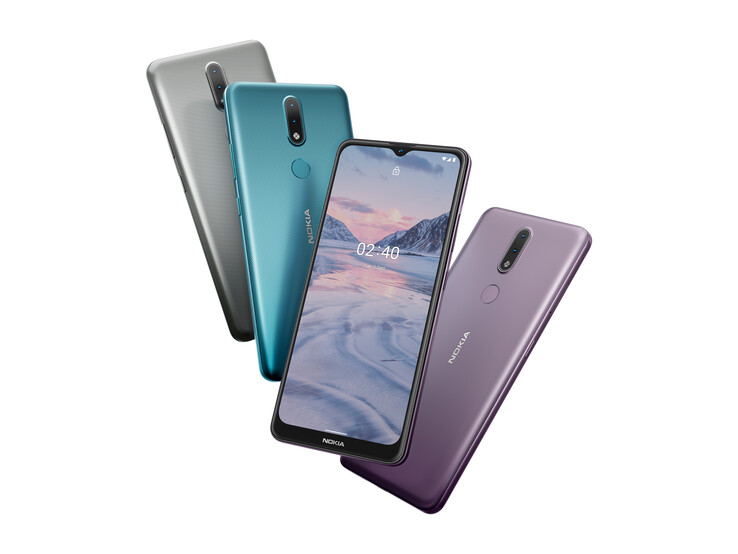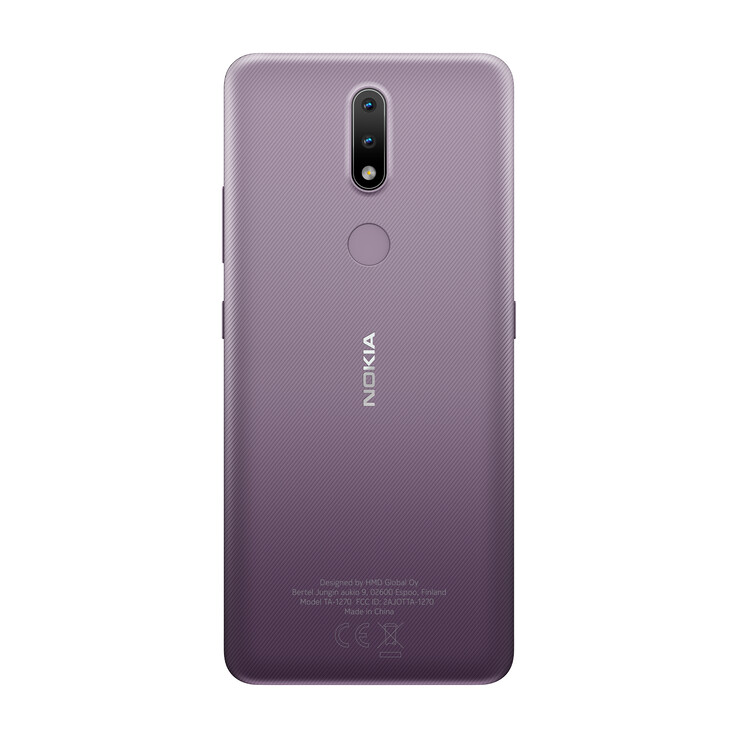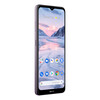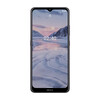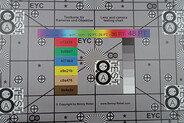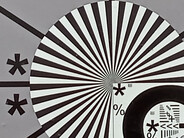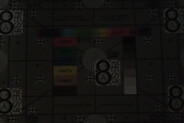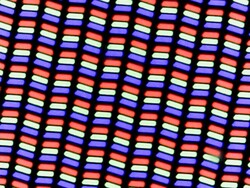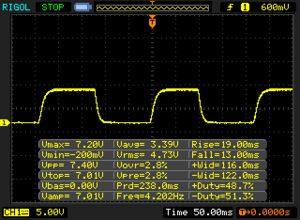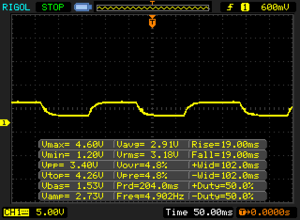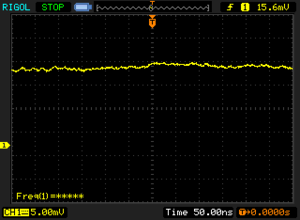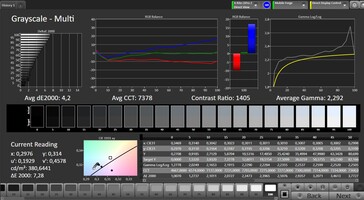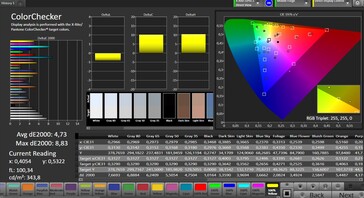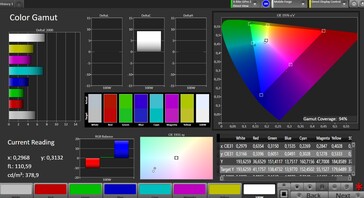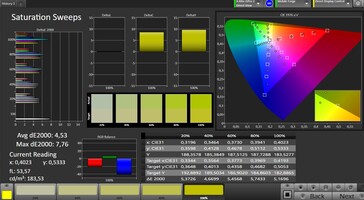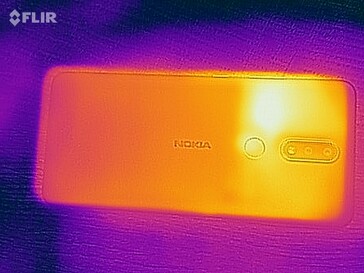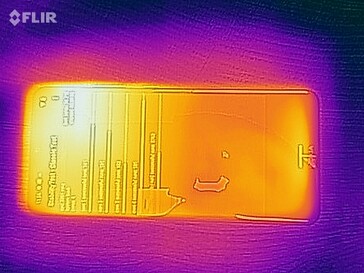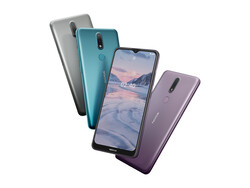Nokia 2.4 Smartphone Review - Is the single camera sufficient?
Comparison devices
Bewertung | Rating Version | Datum | Modell | Gewicht | Laufwerk | Groesse | Aufloesung | Preis ab |
|---|---|---|---|---|---|---|---|---|
| 74.5 % v7 (old) | v7 (old) | 10 / 2020 | Nokia 2.4 Helio P22 MT6762, PowerVR GE8320 | 195 g | 32 GB eMMC Flash | 6.50" | 1600x720 | |
| 74.3 % v7 (old) | v7 (old) | 09 / 2020 | Huawei Y6p Helio P22 MT6762, PowerVR GE8320 | 185 g | 64 GB eMMC Flash | 6.30" | 1600x720 | |
| 75.9 % v7 (old) | v7 (old) | 09 / 2020 | LG K51S Helio P35 MT6765, PowerVR GE8320 | 195 g | 64 GB eMMC Flash | 6.55" | 1600x720 | |
| 77.8 % v7 (old) | v7 (old) | 09 / 2020 | Xiaomi Redmi 9 Helio G80, Mali-G52 MP2 | 198 g | 32 GB eMMC Flash | 6.53" | 2340x1080 |
Case, features and operation - Nokia cell phone with little memory
The Nokia 2.4 offers three color variants with names like from the far north, matching its origin: In addition to the gray Charcoal, there is also the pale violet Dusk and the ice-blue Fjord. The case is made of polycarbonate and is quite stable, but it creaks when twisted. The backside has a light structure, which makes the impression of a higher quality.
The Nokia 2.4 has a large screen and is therefore less suitable for smaller hands, but at 195 grams it is on a par with other smartphones in this price range.
With just 32 GB data memory and 2 GB RAM you have to get by, internationally a variant with 64 GB mass memory and 3 GB RAM is also offered, but this is not available in Central Europe. Thus, the Nokia 2.4 is still on the usual level in its price class, even though the memory is of course scarce in itself. Two SIM cards can be used in the smartphone, for the microSD card there is a dedicated slot.
LTE Cat.4 is of course rather slow, and when it comes to WLAN, all comparable devices are also faster.
A fingerprint sensor can be found on the back of the phone, so it can be unlocked quite quickly, but you should plan for a slight waiting time. In general, delays in operation cannot be ruled out, especially when complex apps are running in the background. The touchscreen is easy to use, however, and is sensitive enough even at the edges.
| Networking | |
| iperf3 transmit AX12 | |
| Xiaomi Redmi 9 | |
| Huawei Y6p | |
| LG K51S | |
| Nokia 2.4 | |
| iperf3 receive AX12 | |
| Xiaomi Redmi 9 | |
| Huawei Y6p | |
| LG K51S | |
| Nokia 2.4 | |
Cameras - Passable image quality for the money
Compared to other cheap smartphones, the Nokia 2.4 comes with a rather scarce camera equipment: Only 2 lenses are found on the back, of which only one can actually be used for pictures. The main camera has a resolution of 13 megapixels, so in terms of resolution the Nokia phone can at least keep up.
The image quality is acceptable for the price range, slight double contours are visible on some objects, the sharpness is moderate and details appear rather coarse on the surrounding image. In low light and high contrasts, the brightening is not bad at all, but details become blurred. If, on the other hand, there is almost no light at all, hardly anything is visible on the image. This is evident in our shots in the test lab, where we can control the lighting conditions. Under normal lighting conditions the camera shows up quite neatly, text remains well defined even against colored backgrounds and the screen doesn't drop too much towards the edge. All in all for the price range a decent presentation of the main camera.
On the front side is a 5 megapixel camera for selfies in a small waterdrop notch. Colors look a bit pale, but in general the image quality is ok in good lighting.
Image comparison
Choose a scene and navigate within the first image. One click changes the position on touchscreens. One click on the zoomed-in image opens the original in a new window. The first image shows the scaled photograph of the test device.
Hauptobjektiv BlumeHauptobjektiv UmgebungHauptobjektiv Low Light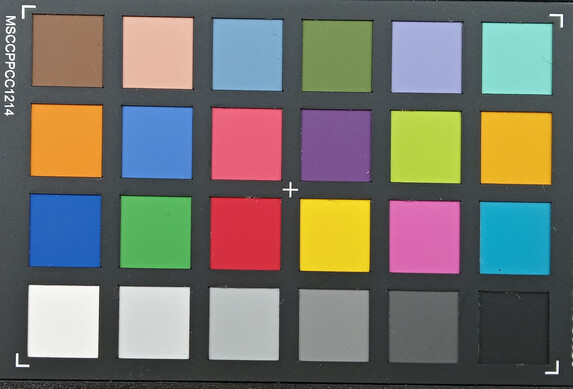
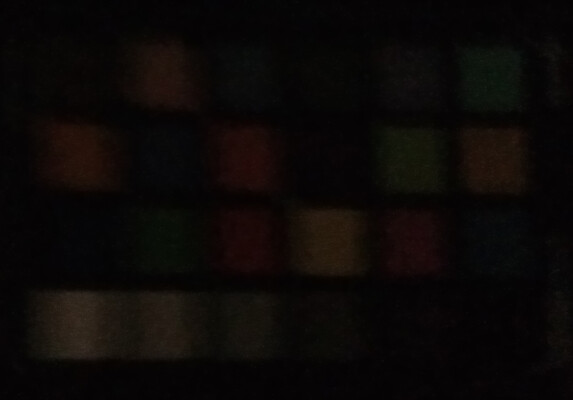
Display - Good contrast values
The rather large screen of the Nokia 2.4 has an extended 720p resolution. The brightness is on class level, the black level even quite low, so that colors shine a bit stronger, because the contrast values are good. Also the color deviations, which we determine with the software CalMAN, are in the usual range for this class, especially lighter blue tones are only moderately accurate. A blue cast is also visible in the display.
There is no PWM flickering on this screen, the response times are not fast enough for applications where every millisecond counts, such as fast action games. But the smartphone is not the optimal choice for this anyway.
| |||||||||||||||||||||||||
Brightness Distribution: 85 %
Center on Battery: 445 cd/m²
Contrast: 1712:1 (Black: 0.26 cd/m²)
ΔE ColorChecker Calman: 4.73 | ∀{0.5-29.43 Ø4.77}
ΔE Greyscale Calman: 4.2 | ∀{0.09-98 Ø5}
94% sRGB (Calman 2D)
Gamma: 2.292
CCT: 7378 K
| Nokia 2.4 IPS, 1600x720, 6.5" | Huawei Y6p IPS, 1600x720, 6.3" | LG K51S IPS, 1600x720, 6.6" | Xiaomi Redmi 9 IPS LCD, 2340x1080, 6.5" | |
|---|---|---|---|---|
| Response Times | 25% | 1% | 2% | |
| Response Time Grey 50% / Grey 80% * (ms) | 38 ? | 36 ? 5% | 42 ? -11% | 46 ? -21% |
| Response Time Black / White * (ms) | 32 ? | 18 ? 44% | 28 ? 12% | 24 ? 25% |
| PWM Frequency (Hz) | 500 ? | |||
| Screen | -3% | -16% | -15% | |
| Brightness middle (cd/m²) | 445 | 563 27% | 407 -9% | 476 7% |
| Brightness (cd/m²) | 405 | 538 33% | 393 -3% | 436 8% |
| Brightness Distribution (%) | 85 | 84 -1% | 95 12% | 86 1% |
| Black Level * (cd/m²) | 0.26 | 0.39 -50% | 0.53 -104% | 0.67 -158% |
| Contrast (:1) | 1712 | 1444 -16% | 768 -55% | 710 -59% |
| Colorchecker dE 2000 * | 4.73 | 4.52 4% | 4.17 12% | 3.51 26% |
| Colorchecker dE 2000 max. * | 8.83 | 8.86 -0% | 8.28 6% | 9.38 -6% |
| Greyscale dE 2000 * | 4.2 | 4.9 -17% | 3.8 10% | 1.5 64% |
| Gamma | 2.292 96% | 2.236 98% | 2.235 98% | 2.166 102% |
| CCT | 7378 88% | 7654 85% | 7227 90% | 6485 100% |
| Total Average (Program / Settings) | 11% /
3% | -8% /
-13% | -7% /
-11% |
* ... smaller is better
Display Response Times
| ↔ Response Time Black to White | ||
|---|---|---|
| 32 ms ... rise ↗ and fall ↘ combined | ↗ 19 ms rise | |
| ↘ 13 ms fall | ||
| The screen shows slow response rates in our tests and will be unsatisfactory for gamers. In comparison, all tested devices range from 0.1 (minimum) to 240 (maximum) ms. » 85 % of all devices are better. This means that the measured response time is worse than the average of all tested devices (20.2 ms). | ||
| ↔ Response Time 50% Grey to 80% Grey | ||
| 38 ms ... rise ↗ and fall ↘ combined | ↗ 19 ms rise | |
| ↘ 19 ms fall | ||
| The screen shows slow response rates in our tests and will be unsatisfactory for gamers. In comparison, all tested devices range from 0.165 (minimum) to 636 (maximum) ms. » 54 % of all devices are better. This means that the measured response time is worse than the average of all tested devices (31.6 ms). | ||
Screen Flickering / PWM (Pulse-Width Modulation)
| Screen flickering / PWM not detected | |||
In comparison: 53 % of all tested devices do not use PWM to dim the display. If PWM was detected, an average of 8083 (minimum: 5 - maximum: 343500) Hz was measured. | |||
Performance, emissions and battery life - Lasts 2 days
The MediaTek Helio P22 is a SoC for low-cost smartphones that is popular in this price range. The Xiaomi Redmi 9 with its Helio G80 is clearly superior, but the other comparison devices are on a very similar level or in the PC Mark even slower than the Nokia 2.4, and this despite the fact that our test device has less RAM.
For its capabilities, the Nokia 2.4 does not do badly in terms of speed. But that does not mean that you could call it "fast": Navigation through the system rarely causes problems, but running more complex apps in the background, increasing or decreasing the volume is only possible with a delay.
The internal memory is also not the fastest, but the reference microSD Toshiba Exceria Pro M501 is read and written quite fast.
The smartphone has no problems with excessive heating. The loudspeaker is a bit quiet and doesn't offer any audible low frequencies, but it is sufficient for occasional listening to music. Better is the 3.5mm audio port or the Bluetooth interface, here clean sound is transmitted.
The Akku precipitates with 4.500 mAh quite sumptuously, Nokia gets also tidy run times out with 13:46 hours in our WLAN test. That is actually also enough for the two days of average usage, which Nokia states for its Smartphone. However, you can only charge the Nokia 4.2 with a maximum of 5 watts, which means that it takes up to 3 hours until the smartphone is fully charged again, so you have to be patient here.
| PCMark for Android | |
| Work performance score (sort by value) | |
| Nokia 2.4 | |
| Huawei Y6p | |
| LG K51S | |
| Xiaomi Redmi 9 | |
| Average Mediatek Helio P22 MT6762 (4404 - 7465, n=18) | |
| Work 2.0 performance score (sort by value) | |
| Nokia 2.4 | |
| Huawei Y6p | |
| LG K51S | |
| Xiaomi Redmi 9 | |
| Average Mediatek Helio P22 MT6762 (3805 - 5380, n=21) | |
| GFXBench | |
| on screen Aztec Ruins Normal Tier Onscreen (sort by value) | |
| Nokia 2.4 | |
| Huawei Y6p | |
| LG K51S | |
| Average Mediatek Helio P22 MT6762 (6.4 - 7.6, n=21) | |
| Average of class Smartphone (6.2 - 166, n=211, last 2 years) | |
| 1920x1080 Aztec Ruins Normal Tier Offscreen (sort by value) | |
| Nokia 2.4 | |
| Huawei Y6p | |
| LG K51S | |
| Average Mediatek Helio P22 MT6762 (3.5 - 4.7, n=21) | |
| Average of class Smartphone (3.4 - 367, n=211, last 2 years) | |
| on screen Aztec Ruins High Tier Onscreen (sort by value) | |
| Nokia 2.4 | |
| Huawei Y6p | |
| LG K51S | |
| Average Mediatek Helio P22 MT6762 (4.1 - 4.8, n=21) | |
| Average of class Smartphone (0.85 - 144, n=212, last 2 years) | |
| 2560x1440 Aztec Ruins High Tier Offscreen (sort by value) | |
| Nokia 2.4 | |
| Huawei Y6p | |
| LG K51S | |
| Average Mediatek Helio P22 MT6762 (1.3 - 1.6, n=21) | |
| Average of class Smartphone (1.2 - 146, n=211, last 2 years) | |
| Nokia 2.4 | Huawei Y6p | LG K51S | Xiaomi Redmi 9 | Average 32 GB eMMC Flash | Average of class Smartphone | |
|---|---|---|---|---|---|---|
| AndroBench 3-5 | 9% | 8% | 33% | -9% | 1071% | |
| Sequential Read 256KB (MB/s) | 245.7 | 278 13% | 266.1 8% | 289.9 18% | 242 ? -2% | 2248 ? 815% |
| Sequential Write 256KB (MB/s) | 119.5 | 160 34% | 165.2 38% | 119.8 0% | 100.5 ? -16% | 1887 ? 1479% |
| Random Read 4KB (MB/s) | 46 | 55.2 20% | 58.9 28% | 49.09 7% | 43.1 ? -6% | 299 ? 550% |
| Random Write 4KB (MB/s) | 22.5 | 19.4 -14% | 18.8 -16% | 60.7 170% | 22.3 ? -1% | 346 ? 1438% |
| Sequential Read 256KB SDCard (MB/s) | 82.6 ? | 82.8 ? 0% | 79.6 ? -4% | 84.4 ? 2% | 71.8 ? -13% | |
| Sequential Write 256KB SDCard (MB/s) | 63 ? | 62.5 ? -1% | 59.3 ? -6% | 65 ? 3% | 52.9 ? -16% |
Temperature
(+) The maximum temperature on the upper side is 37.9 °C / 100 F, compared to the average of 35.2 °C / 95 F, ranging from 21.9 to 247 °C for the class Smartphone.
(+) The bottom heats up to a maximum of 39.8 °C / 104 F, compared to the average of 34 °C / 93 F
(+) In idle usage, the average temperature for the upper side is 25.3 °C / 78 F, compared to the device average of 32.9 °C / 91 F.
Speakers
Nokia 2.4 audio analysis
(±) | speaker loudness is average but good (78.6 dB)
Bass 100 - 315 Hz
(-) | nearly no bass - on average 59.8% lower than median
(+) | bass is linear (0% delta to prev. frequency)
Mids 400 - 2000 Hz
(-) | nearly no mids - on average 59.8% lower than median
(+) | mids are linear (0% delta to prev. frequency)
Highs 2 - 16 kHz
(-) | nearly no highs - on average 59.8% lower than median
(+) | highs are linear (0% delta to prev. frequency)
Overall 100 - 16.000 Hz
(-) | overall sound is not linear (122.9% difference to median)
Compared to same class
» 91% of all tested devices in this class were better, 7% similar, 1% worse
» The best had a delta of 11%, average was 35%, worst was 134%
Compared to all devices tested
» 97% of all tested devices were better, 2% similar, 0% worse
» The best had a delta of 4%, average was 24%, worst was 134%
Xiaomi Redmi 9 audio analysis
(+) | speakers can play relatively loud (83.7 dB)
Bass 100 - 315 Hz
(-) | nearly no bass - on average 69.2% lower than median
(+) | bass is linear (0% delta to prev. frequency)
Mids 400 - 2000 Hz
(-) | nearly no mids - on average 69.2% lower than median
(+) | mids are linear (0% delta to prev. frequency)
Highs 2 - 16 kHz
(-) | nearly no highs - on average 69.2% lower than median
(+) | highs are linear (0% delta to prev. frequency)
Overall 100 - 16.000 Hz
(-) | overall sound is not linear (119.4% difference to median)
Compared to same class
» 88% of all tested devices in this class were better, 8% similar, 3% worse
» The best had a delta of 11%, average was 35%, worst was 134%
Compared to all devices tested
» 96% of all tested devices were better, 3% similar, 1% worse
» The best had a delta of 4%, average was 24%, worst was 134%
Battery life
| Nokia 2.4 4500 mAh | Huawei Y6p 5000 mAh | LG K51S 4000 mAh | Xiaomi Redmi 9 5020 mAh | Average of class Smartphone | |
|---|---|---|---|---|---|
| Battery Runtime | |||||
| WiFi Websurfing (h) | 13.8 | 15.9 15% | 13.4 -3% | 13.4 -3% | 19.3 ? 40% |
Pros
Cons
Verdict - The camera can be sufficient
For just under 130 euros manufacturer's price, the Nokia 2.4 is a fair offer, whose single camera is not as flexible as some other low-cost smartphones, but still takes decent pictures overall. The battery life and performance are typical for this class, the case is reasonably stable and the offered color options are chic. There is no excessive heating, the screen is on class level and even offers quite decent contrast values.
The Nokia 2.4 offers decent camera quality. Otherwise, the cheap smartphone is also recommended if you don't need a fast WLAN.
For itself one can recommend the Nokia 2.4 thus if the slow WLAN rates and the eternal battery charge times do not disturb you. But there is already the Xiaomi Redmi 9 for a few euros more, which is much better in many areas.
Thanks to the Android-One program, the security updates for the Nokia phone should be secured for the next few years, which is of course a big advantage over other cheap smartphones, which are often forgotten by the manufacturers.
Nokia 2.4
- 10/19/2020 v7 (old)
Florian Schmitt


